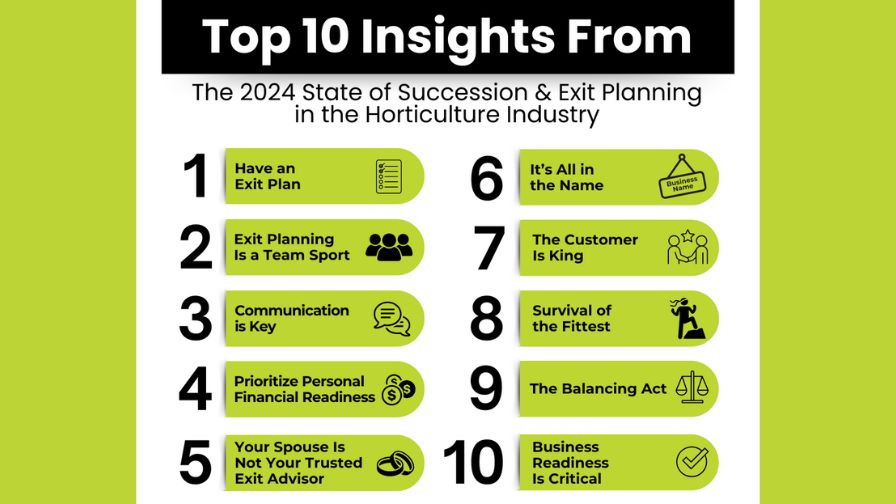
Top 10 Insights from the ‘2024 State of Succession & Exit Planning in the Horticulture Industry’ survey | PivotPoint Business Solutions
As we step into the new year, it’s the perfect moment to reflect on 2024 and set the stage for a successful 2025. Perhaps that is why we see so many “Year in Review” and “Best of 2024” articles on various subjects.
For horticulture business owners, succession and exit planning emerged as a critical theme in the first-ever “2024 State of Succession and Exit Planning in the Horticulture Industry” survey conducted by PivotPoint Business Solutions. Among the 10 key findings from the survey, three vital themes stand out as critical points to address in 2025:
- The importance of planning
- Investing in human capital
- Fostering communication
These themes not only serve as a guide to overcoming challenges but also provide a clear roadmap for creating long-term business success.
Change is in the air. We have a new year, a new administration, and new technologies. If the prospect of addressing your future succession feels overwhelming and winding down operations seems like the simpler choice, consider approaching the challenge with a fresh perspective. Start the new year with a commitment to these three key themes, transforming them into actionable resolutions for 2025:
1. The Importance of Planning
“Someone’s sitting in the shade today because someone planted a tree a long time ago.” – Warren Buffett
Planning is the foundation of a successful transition. Yet, many business owners delay or avoid this critical step, often to the detriment of their businesses and families. Succession and exit planning aren’t just about leaving your business; they’re about building value, ensuring continuity, and preparing for both opportunities and challenges.
Key Takeaways:
Planning is essential: The survey revealed that 32% of horticulture business owners lack an exit plan. Among those aiming to exit within two years, 55% haven’t started planning.
Time is critical: Building and executing an exit plan can take 3-5 years, allowing for value maximization and structured transitions.
Avoid risks of inaction: Businesses without a plan are more likely to face reduced value, forced liquidation, or unprepared transitions during unforeseen events like death, disability, divorce, disagreement between owners, or business distress.
2025 Resolution:
A well-crafted plan is the cornerstone of a successful business transition. In 2025, resolve to take proactive steps to create or refine your succession and exit strategy:
- Start planning now, regardless of your timeline. Early action ensures a successful exit and avoids costly mistakes. Whether you’re 40 or 60, it is never too early.
- Set clear goals for your transition, including timelines and desired outcomes.
- Consult with professionals to create a comprehensive succession and exit strategy.
2. The Importance of Your Human Capital
“Great things in business are never done by one person. They’re done by a team of people.” – Steve Jobs
A thriving business relies on its people. From your management team to shipping, and your frontline workers, every employee plays a role in your company’s success. However, many business owners struggle with delegating responsibilities, leading to owner dependence and reduced business value.
Key Takeaways:
Team building matters: 58% of business owners prioritize building a team that can operate independently, but only 8% spend sufficient time on human resource development.
Owner dependence is a value killer:
- 65% of respondents haven’t taken a two-week vacation in over two years.
- Businesses overly reliant on owners are less attractive to buyers and successors.
Invest in talent: Retaining and developing skilled employees ensures continuity and mitigates labor shortages and generational gaps.
2025 Resolution:
Your team is your greatest asset. In 2025, commit to strengthening and empowering your team:
3. The Importance of Communication
“Communicate everything you can to your associates. The more they know, the more they’ll care. Once they care, there’s no stopping them.” – Sam Walton
Communication is the glue that holds a team together during times of change. Regular, transparent dialogue with your team — whether family, employees, or potential successors — can alleviate uncertainties and foster a sense of shared purpose. Yet, many owners hesitate to share their plans, creating unnecessary tension and instability.
Key Takeaways:
Transparency builds trust:
- Just 47% of respondents have a plan to inform their team about their intention to exit the business. Only 34% of owners share their plans with their teams, with only 30% partially informing them.
- Lack of communication causes uncertainty, leading to employee turnover.
Engage your team: Involve employees in your succession planning to foster loyalty and reduce operational risks.
Reward loyalty: Implement retention bonuses or phantom stock programs to motivate key employees during transitions.
2025 Resolution:
Clear and consistent communication is crucial for a smooth transition. Make 2025 the year you prioritize transparency and collaboration:
- Foster open dialogue with your team about your plans and vision.
- Develop a strategy to share your exit plan at the appropriate time.
- Create incentives to reward employee loyalty and involvement in the transition process.
Looking Ahead
By addressing these priorities, you can build a resilient, valuable business ready for any future transition. Whether your exit is five years or two decades away, these resolutions set the foundation for success.
Key Actions for 2025:
- Prioritize strategic planning to secure a successful business transition.
- Invest in your team by hiring and developing top talent.
- Communicate openly with your team to build trust and engagement.

